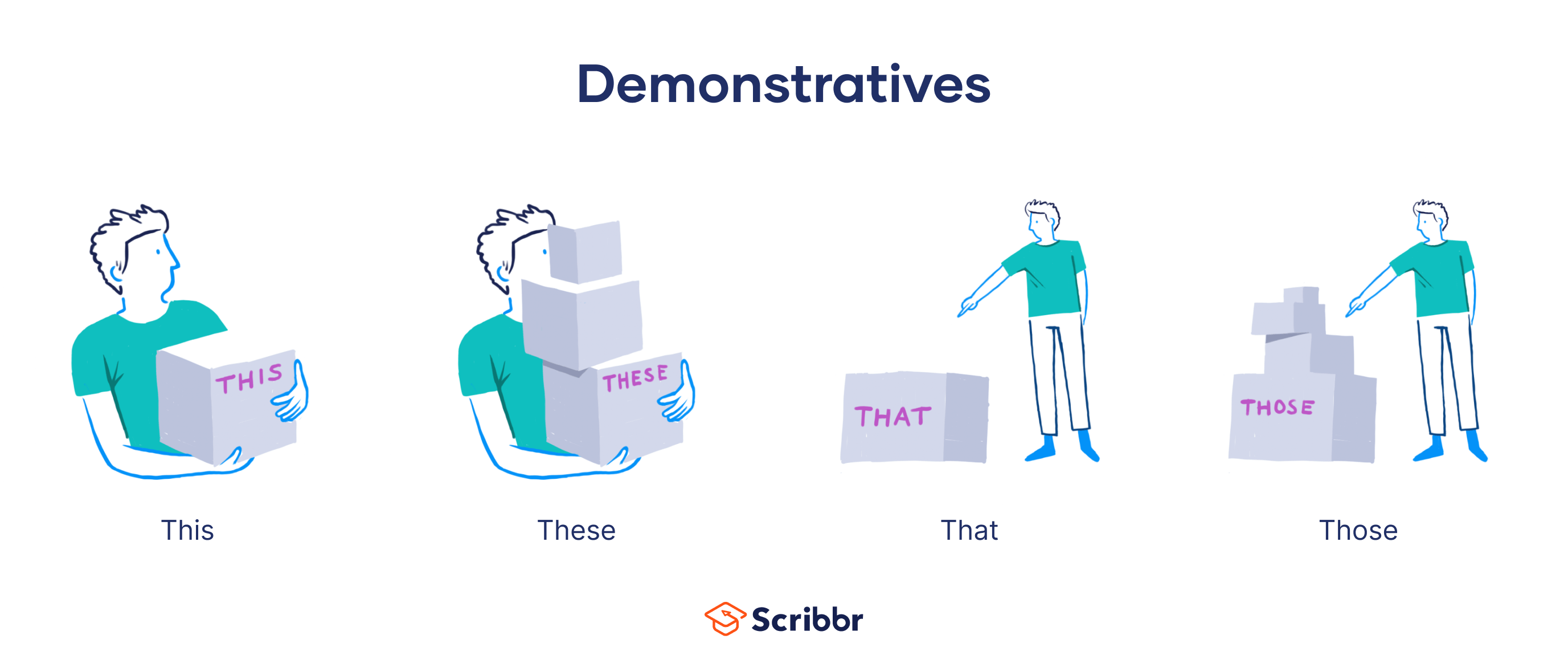Demonstrative Pronouns | Definition, List & Examples
The four English demonstrative pronouns are this, that, these, and those. They are used to highlight something that was previously mentioned or that is clear from the context.
Demonstrative pronouns ‘demonstrate’ something; using them is the verbal equivalent of pointing at something or someone. They draw attention to the thing or person you’re referring to.
Demonstrative pronouns indicate number (singular or plural) and the relative distance of the thing being referred to.
| Near (proximal) | Far (distal) | |
|---|---|---|
| Singular | This is my friend Jamie. | I don’t know about that. Let’s discuss it tomorrow. |
| Plural | I like all kinds of chocolates, but these are my favourites. | Those are my notebooks on the desk. |
Demonstrative pronouns vs demonstrative determiners
The demonstrative pronouns are identical to the demonstrative determiners (often called demonstrative adjectives instead). The same words – this, that, these, and those – are used for both grammatical functions in English. The pronouns and determiners together can be collectively referred to as demonstratives.
- A demonstrative pronoun replaces a noun, meaning that it stands alone as the subject or object of the sentence.
- A demonstrative determiner modifies a noun, meaning that it appears before the noun, telling you something about it.
These are very good chocolates, but I still prefer these peanuts.
I’m afraid I can’t answer that question. This is a classified investigation.
‘Near’ and ‘far’ demonstratives
Demonstratives – both pronouns and determiners – are used to indicate the distance of the thing or person being referred to from the person speaking or writing.
- This (singular) and these (plural) are the ‘near’ (or proximal) demonstratives. They indicate someone or something that is relatively close.
- That (singular) and those (plural) are the ‘far’ (or distal) demonstratives. They indicate someone or something that is relatively far.
This can refer to literal physical distance – for example, contrasting the distance of two physical objects, people, or locations from the speaker or writer.
No, this is my uncle Bill. That’s my dad over there.
That’s the Van Gogh Museum in the distance, and this building on our left is the concert hall.
It can also mean distance in time, when you’re contrasting the past or future with the present.
Finally, demonstratives may indicate a more abstract, figurative type of distance – for example, referring to something that was previously said or to some idea, concept, or event.
This argument isn’t getting us anywhere. Let’s agree to disagree.
Two major events are often said to mark the beginning of modern European history. These are the French Revolution and the Industrial Revolution.
Antecedents of demonstrative pronouns
The antecedent of a pronoun is the noun or phrase it refers to. The antecedent usually appears before the pronoun – earlier in the sentence or in a previous sentence. But it can sometimes appear shortly after the pronoun.
This is my fear: that we aren’t doing enough.
But demonstrative pronouns, because of the way they’re used, don’t always have explicitly named antecedents. When the implied antecedent is clear from the context, that isn’t a problem.
I want these! [antecedent = the toys the speaker is holding]
What’s that? [antecedent = the building in the distance that the speaker is pointing at]
In the context in which they were said, the above sentences would all be perfectly clear, although they are ambiguous without that context.
Ambiguous antecedents
There’s a problem if the antecedent of a demonstrative pronoun is unclear even in context.
It’s important (especially in academic writing) to make the antecedent completely clear, typically by writing the noun phrase you’re referring to in addition to or instead of the demonstrative or by rephrasing to eliminate any confusion.
- The income gap between rich and poor has continued to widen over the past decade, contrary to mainstream economists’ predictions. This indicates that new models are required to understand this.
- The income gap between rich and poor has continued to widen over the past decade, contrary to mainstream economists’ predictions. The disparity between theory and reality indicates that new models are required to understand this trend.
- The income gap between rich and poor has continued to widen over the past decade. This is contrary to mainstream economists’ predictions, which indicates that new models are required to understand the widening gap.
Demonstratives vs relative pronouns
As well as being a demonstrative, the word that can also be used as a relative pronoun. Relative pronouns are used to introduce relative clauses – phrases that provide more information about the preceding noun.
The other demonstratives (this, these, and those) are not used as relative pronouns.
Frequently asked questions
Sources for this article
We strongly encourage students to use sources in their work. You can cite our article (APA Style) or take a deep dive into the articles below.
This Scribbr articleCaulfield, J. (2023, November 27). Demonstrative Pronouns | Definition, List & Examples. Scribbr. Retrieved 22 December 2025, from https://www.scribbr.co.uk/nouns/demonstrative-pronoun/
Aarts, B. (2011). Oxford modern English grammar. Oxford University Press.
Butterfield, J. (Ed.). (2015). Fowler’s dictionary of modern English usage (4th ed.). Oxford University Press.
Garner, B. A. (2016). Garner’s modern English usage (4th ed.). Oxford University Press.




